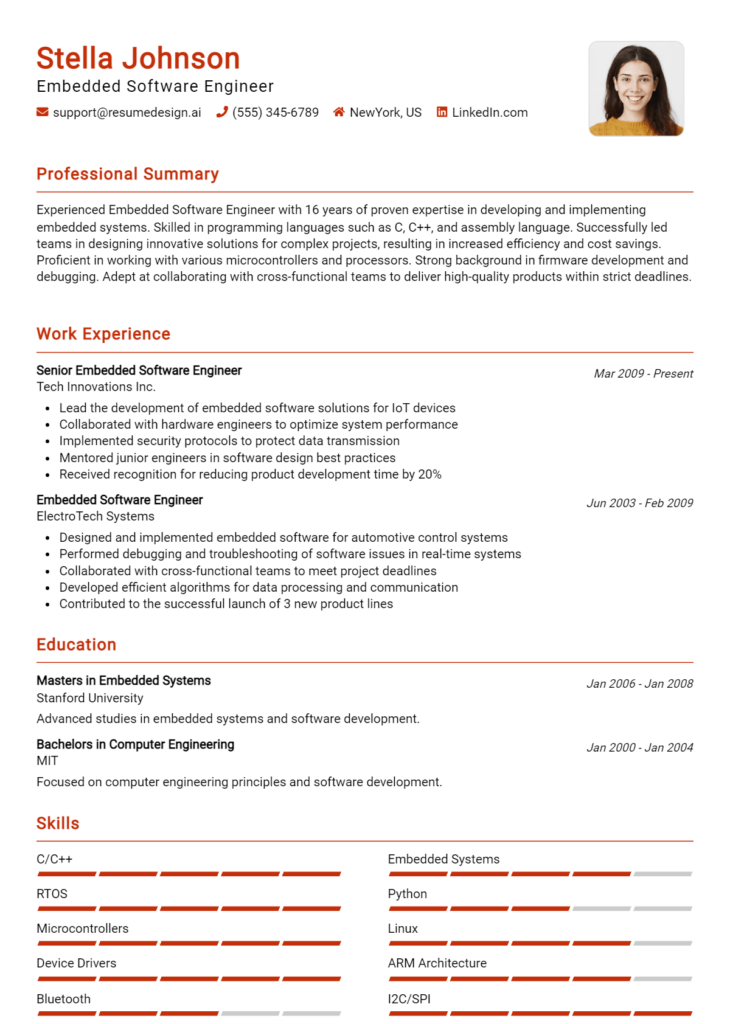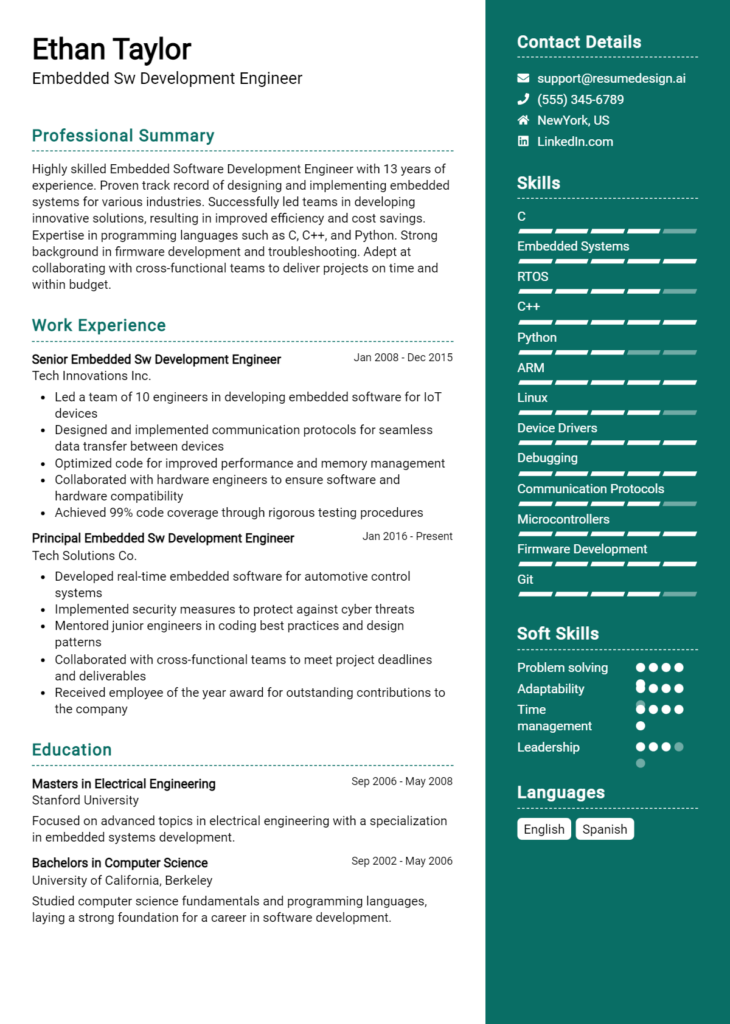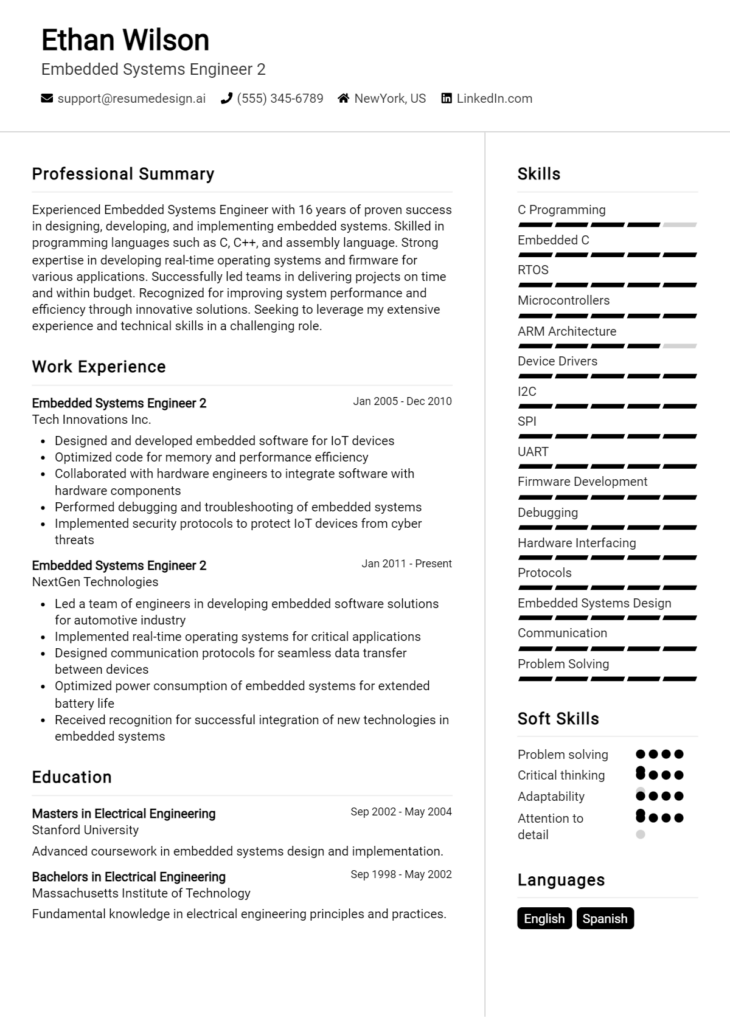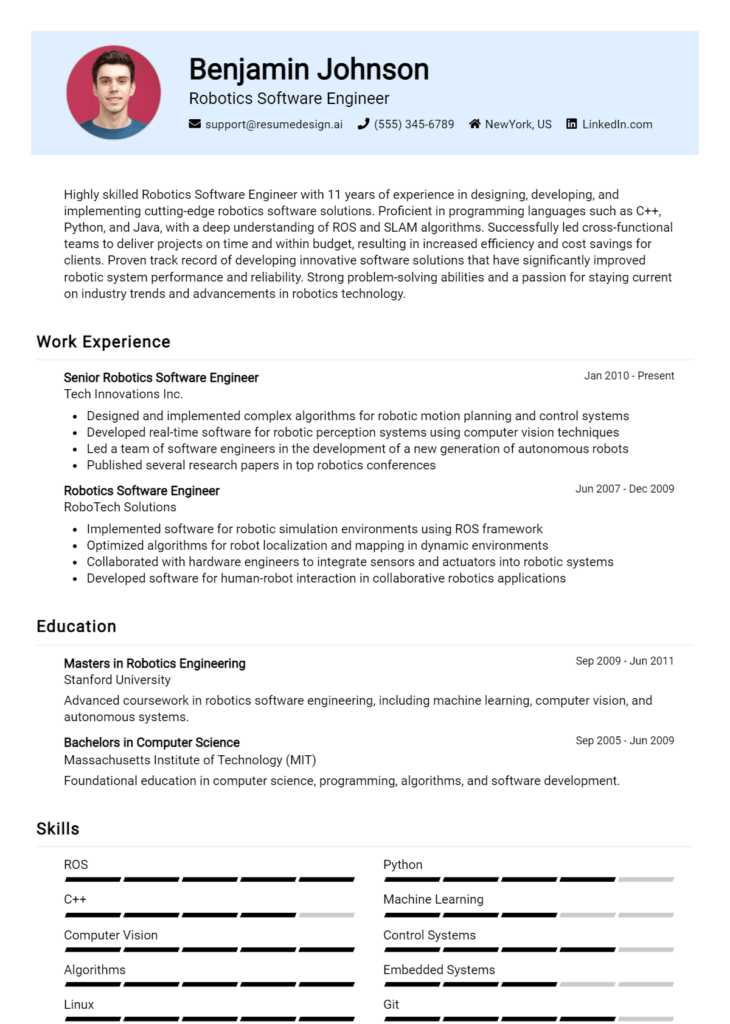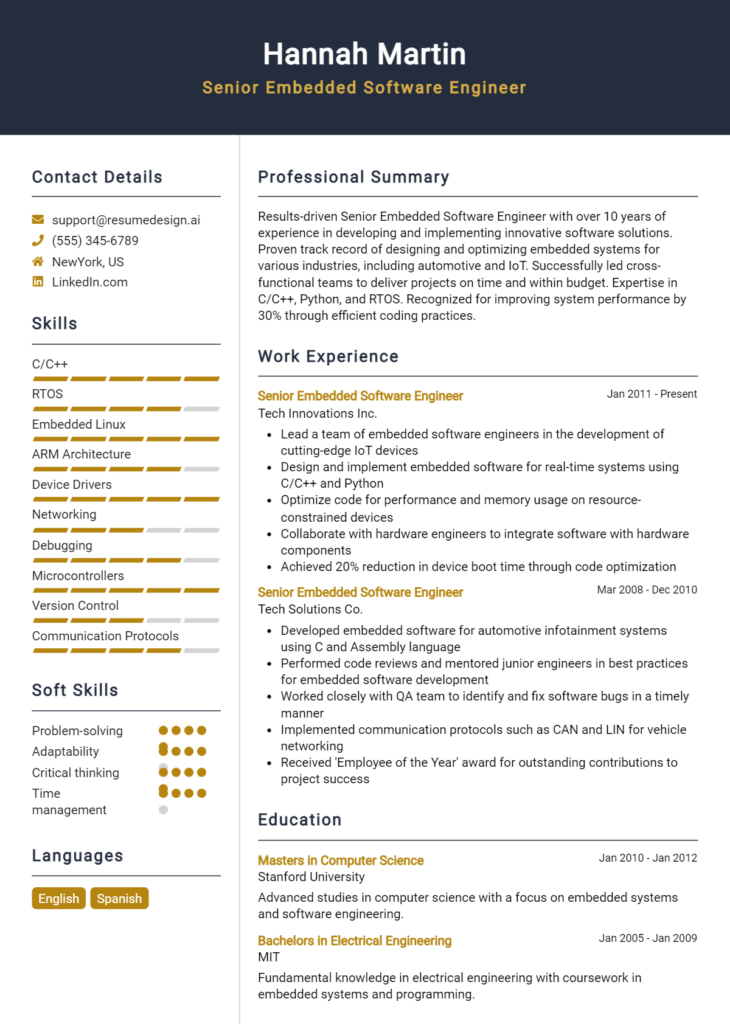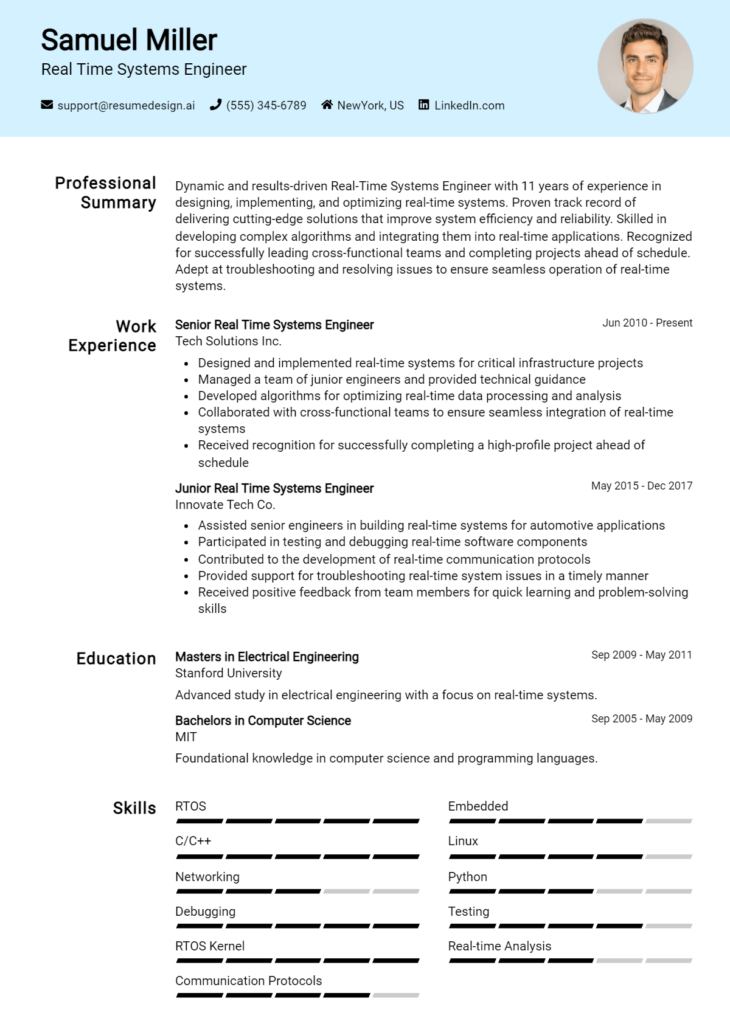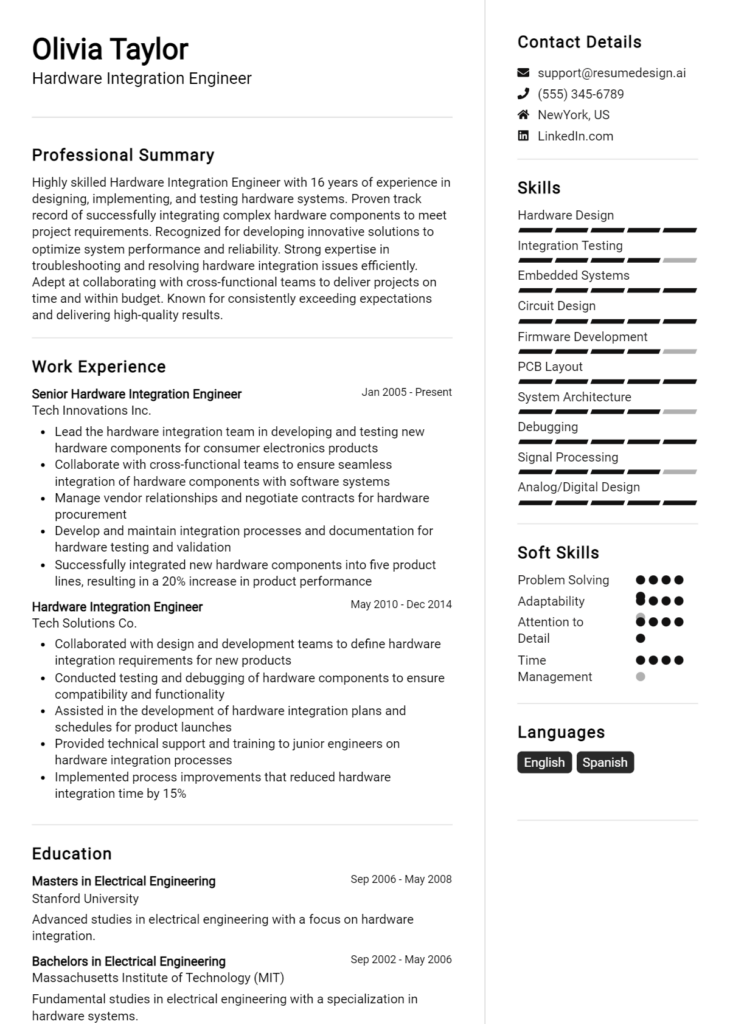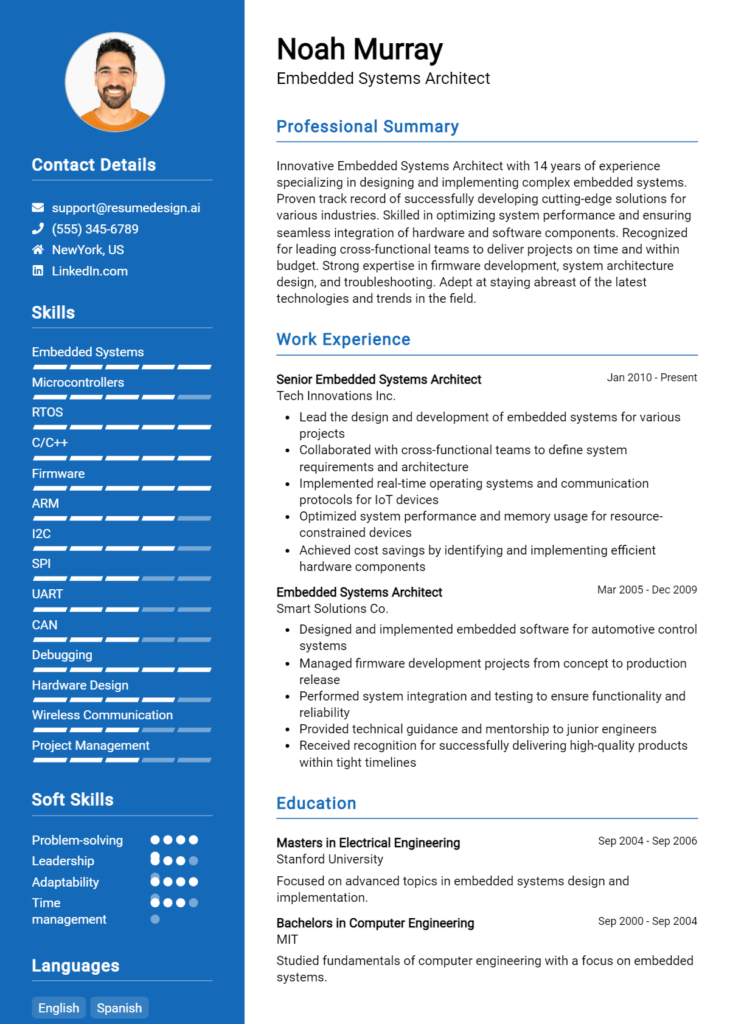IoT Firmware Engineer Core Responsibilities
IoT Firmware Engineers play a crucial role in developing and optimizing software for Internet of Things devices, requiring a blend of technical, operational, and problem-solving skills. They collaborate across departments, ensuring seamless integration between hardware and software while troubleshooting issues that arise during product development. A strong foundation in programming languages, embedded systems, and network protocols is essential. Highlighting these skills in a well-structured resume can effectively demonstrate how they contribute to the organization’s innovative goals.
Common Responsibilities Listed on IoT Firmware Engineer Resume
- Design and develop firmware for IoT devices.
- Collaborate with hardware engineers to ensure compatibility.
- Conduct testing and debugging of firmware to enhance performance.
- Implement security measures for IoT applications.
- Document firmware specifications and development processes.
- Optimize existing firmware for improved efficiency.
- Stay updated on emerging IoT technologies and trends.
- Assist in the integration of cloud services with IoT solutions.
- Provide technical support and troubleshooting for firmware-related issues.
- Participate in cross-functional teams to align project goals.
- Contribute to the development of user manuals and guides.
High-Level Resume Tips for IoT Firmware Engineer Professionals
A well-crafted resume is crucial for IoT Firmware Engineer professionals, as it serves as the first impression a candidate makes on potential employers. In a competitive field that merges hardware and software innovations, your resume must effectively reflect both your technical skills and notable achievements. This guide will equip you with practical and actionable resume tips specifically tailored for IoT Firmware Engineer roles, ensuring that you stand out in a crowded job market.
Top Resume Tips for IoT Firmware Engineer Professionals
- Tailor your resume for each job application by closely aligning your skills and experience with the job description.
- Highlight relevant experience in embedded systems, firmware development, and IoT protocols such as MQTT, CoAP, and HTTP.
- Quantify your achievements, such as the percentage of performance improvement or the reduction of power consumption in projects you have worked on.
- Showcase your proficiency in programming languages commonly used in IoT, such as C, C++, Python, and Java.
- Include any relevant certifications, such as those related to IoT, embedded systems, or specific programming languages.
- Demonstrate your understanding of hardware interfaces and protocols, such as SPI, I2C, UART, and GPIO.
- Emphasize your experience with debugging tools and methodologies, showcasing your problem-solving skills.
- Incorporate keywords from the job description to make your resume more discoverable by applicant tracking systems (ATS).
- Keep the format clean and professional, ensuring easy readability and clear section headings.
- Include a summary statement that encapsulates your expertise in IoT and firmware development, highlighting what you bring to the table.
By implementing these tips, you enhance the clarity and impact of your resume, significantly increasing your chances of landing a job in the IoT Firmware Engineer field. A targeted, achievement-focused resume will not only showcase your technical capabilities but also demonstrate your readiness to contribute to innovative projects in this rapidly evolving industry.
Why Resume Headlines & Titles are Important for IoT Firmware Engineer
In the competitive realm of IoT (Internet of Things) development, a well-crafted resume headline is crucial for an IoT Firmware Engineer. This brief yet powerful statement serves as a first impression, effectively summarizing a candidate's qualifications and expertise in a concise phrase. A strong headline can instantly capture the attention of hiring managers, providing them with a snapshot of the applicant’s skills and experience relevant to the job. By aligning the headline with the specific requirements of the position being applied for, candidates can enhance their chances of standing out in a crowded field of applicants.
Best Practices for Crafting Resume Headlines for IoT Firmware Engineer
- Keep it concise: Aim for a headline that is no longer than a single sentence.
- Make it role-specific: Tailor your headline to reflect the specific IoT Firmware Engineer role you are applying for.
- Highlight key skills: Include essential skills that are relevant to the position.
- Showcase experience: Mention your years of experience or notable projects in the IoT field.
- Use impactful language: Choose strong action words that convey your strengths and contributions.
- Avoid jargon: Ensure that your headline is easily understood and avoids overused industry jargon.
- Focus on accomplishments: If possible, include a notable achievement to set yourself apart.
- Keep it professional: Ensure your headline maintains a professional tone suitable for the engineering field.
Example Resume Headlines for IoT Firmware Engineer
Strong Resume Headlines
"Innovative IoT Firmware Engineer with 5+ Years in Embedded Systems Development"
“Results-Driven IoT Firmware Specialist | Expert in Low-Power Device Design”
“Experienced Firmware Engineer Focused on Scalable IoT Solutions and Cross-Platform Integration”
Weak Resume Headlines
“Engineer Looking for Opportunities”
“Firmware Developer”
The strong headlines listed above are effective because they provide clear, specific information about the candidate's skills, experience, and focus areas, making them immediately relevant to hiring managers. They highlight the candidate's unique qualifications and contributions, creating a compelling narrative. On the other hand, the weak headlines fail to impress due to their lack of specificity and impact; they do not communicate the candidate's true value or align with the expectations of the role, making it difficult for employers to see how they would fit within their organization.
Writing an Exceptional IoT Firmware Engineer Resume Summary
A resume summary is a critical component for an IoT Firmware Engineer, as it serves as the first impression for hiring managers reviewing applications. A well-crafted summary succinctly highlights the candidate's key skills, relevant experience, and notable accomplishments, allowing them to stand out in a competitive job market. By capturing attention quickly, a strong summary can effectively convey the candidate's suitability for the role, making it essential for it to be concise, impactful, and tailored to the specific job being applied for.
Best Practices for Writing a IoT Firmware Engineer Resume Summary
- Quantify achievements: Use specific numbers or percentages to demonstrate the impact of your work.
- Focus on relevant skills: Highlight technical skills that are directly applicable to the IoT firmware engineering role.
- Tailor your summary: Customize your summary for each job application to align with the job description.
- Use strong action verbs: Start sentences with dynamic verbs to create a sense of proactivity.
- Keep it concise: Aim for 3-5 sentences that deliver maximum information in a minimal amount of space.
- Showcase industry knowledge: Mention familiarity with IoT protocols, embedded systems, or specific technologies relevant to the role.
- Highlight problem-solving abilities: Emphasize your capacity to address challenges and deliver innovative solutions.
Example IoT Firmware Engineer Resume Summaries
Strong Resume Summaries
Dynamic IoT Firmware Engineer with over 5 years of experience in developing scalable firmware solutions for IoT devices. Successfully reduced system boot time by 30% through optimized code and efficient memory management, while enhancing device connectivity reliability by implementing robust communication protocols.
Results-driven Firmware Engineer specializing in IoT applications, with a track record of delivering high-quality software for smart home devices. Developed and deployed firmware updates that improved user experience ratings by 25%, leveraging C/C++ and RTOS for real-time performance.
Innovative IoT Firmware Engineer with a strong background in embedded systems and wireless communication. Led a team that created a low-power firmware solution reducing energy consumption by 40%, directly contributing to a 15% increase in product lifespan.
Weak Resume Summaries
Experienced engineer looking for a job in IoT firmware development. I have some skills in programming and am willing to learn more.
Firmware Engineer with a background in technology. I have worked on various projects and hope to contribute to a company in the IoT sector.
The examples presented illustrate the key differences between strong and weak resume summaries. Strong summaries effectively quantify achievements, specify relevant skills, and directly relate to the IoT Firmware Engineer role, showcasing the candidate's ability to provide tangible benefits. In contrast, weak summaries are vague, lack measurable outcomes, and fail to demonstrate a clear connection to the job, making them less impactful in capturing the interest of hiring managers.
Work Experience Section for IoT Firmware Engineer Resume
The work experience section of an IoT Firmware Engineer resume is critical as it serves as a testament to the candidate's technical proficiency, project management abilities, and commitment to delivering high-quality products. This section not only highlights the specific skills acquired and honed through hands-on experience but also demonstrates the candidate's capacity to lead teams and collaborate effectively within multidisciplinary environments. To stand out, it is essential to quantify achievements and align past experiences with industry standards, showcasing how previous roles have prepared the candidate for future challenges in the rapidly evolving field of IoT.
Best Practices for IoT Firmware Engineer Work Experience
- Emphasize relevant technical skills specific to IoT firmware development, such as programming languages (C, C++, Python), hardware integration, and debugging methodologies.
- Quantify achievements with metrics, such as percentage improvements in performance or reductions in resource consumption.
- Highlight collaborative projects, showcasing your ability to work with cross-functional teams including hardware engineers, software developers, and product managers.
- Detail leadership roles, emphasizing your experience in guiding teams, mentoring junior engineers, or leading projects to successful completion.
- Use action verbs to convey a sense of proactivity and impact in your previous roles.
- Align your experiences with industry standards and emerging technologies, demonstrating awareness of current trends in IoT.
- Incorporate problem-solving examples that highlight your ability to address challenges in firmware development.
- Tailor your experiences to the job description, ensuring relevance to the specific position you are applying for.
Example Work Experiences for IoT Firmware Engineer
Strong Experiences
- Led a team of 5 engineers in developing a low-power firmware solution for a smart home device, achieving a 30% reduction in energy consumption and improving battery life by 50%.
- Designed and implemented a robust firmware update system for over 100,000 devices, resulting in a 95% success rate for OTA updates and reducing customer support calls by 20%.
- Collaborated with cross-functional teams to integrate IoT security protocols into existing firmware, enhancing data protection and increasing compliance with industry standards by 40%.
Weak Experiences
- Worked on firmware for IoT devices.
- Involved in various projects related to smart technology.
- Assisted in team tasks as needed.
The examples categorized as strong exhibit clear, quantifiable outcomes and demonstrate significant technical leadership and collaboration, which are essential for an IoT Firmware Engineer. In contrast, the weak experiences lack specificity, measurable achievements, and fail to demonstrate the candidate's impact or contributions, making them less compelling to potential employers.
Education and Certifications Section for IoT Firmware Engineer Resume
The education and certifications section of an IoT Firmware Engineer resume is crucial in establishing the candidate's academic foundation and technical expertise. This section not only showcases the degrees obtained but also highlights relevant industry certifications and continuous learning efforts that demonstrate a commitment to staying current in a rapidly evolving field. By including pertinent coursework, recognized certifications, and specialized training, candidates can significantly enhance their credibility and better align themselves with the requirements of the job role, making a strong case for their qualifications in the competitive landscape of IoT engineering.
Best Practices for IoT Firmware Engineer Education and Certifications
- Include only relevant degrees and certifications that pertain to IoT and firmware development.
- Detail coursework or projects that demonstrate practical skills and knowledge in IoT technologies.
- Highlight advanced certifications from reputable organizations that are recognized in the industry.
- List certifications in a clear format, including the issuing body and date obtained.
- Consider including a brief description of any specialized training that enhances your qualifications.
- Use clear and concise language to maintain readability and impact.
- Order the education and certifications chronologically or by relevance, placing the most pertinent items at the top.
- Regularly update this section to reflect new achievements and continuous learning efforts.
Example Education and Certifications for IoT Firmware Engineer
Strong Examples
- Bachelor of Science in Computer Engineering, University of Technology, 2021
- Certified Internet of Things Practitioner (CIoTP), IoT Certification Institute, 2022
- Embedded Systems Programming Course, Coursera, completed 2023
- Microcontroller Programming and IoT Applications, Udemy, completed 2022
Weak Examples
- Associate Degree in General Studies, Community College, 2018
- Certification in Microsoft Office, Online Learning Platform, 2020
- High School Diploma, Local High School, 2017
- Basic HTML and CSS Course, Free Online Course, 2019
The examples listed as strong are considered relevant because they directly relate to the skills and knowledge required for an IoT Firmware Engineer role. They showcase a solid educational background in engineering and certifications that demonstrate technical proficiency and specialized training in IoT. On the other hand, the weak examples lack relevance to the field, focusing on general studies or unrelated certifications that do not enhance the candidate's suitability for the specific job role in IoT firmware engineering.
Top Skills & Keywords for IoT Firmware Engineer Resume
In the rapidly evolving field of the Internet of Things (IoT), the role of an IoT Firmware Engineer is crucial to the development and functionality of connected devices. A well-crafted resume that highlights the right skills can significantly enhance a candidate's appeal to potential employers. Both soft and hard skills are essential in this role, as they not only demonstrate technical competence but also showcase the ability to collaborate effectively within interdisciplinary teams. An IoT Firmware Engineer must be adept at problem-solving, communication, and adaptability, while also being proficient in programming, hardware interfacing, and system design. Focusing on the right skills in your resume can set you apart in a competitive job market.
Top Hard & Soft Skills for IoT Firmware Engineer
Soft Skills
- Problem-solving
- Communication
- Team collaboration
- Adaptability
- Critical thinking
- Time management
- Attention to detail
- Creativity
- Analytical thinking
- Project management
Hard Skills
- Embedded C/C++ programming
- Real-time operating systems (RTOS)
- Microcontroller architecture
- IoT protocols (MQTT, CoAP, etc.)
- Wireless communication technologies (Wi-Fi, Bluetooth, Zigbee)
- Hardware interfacing and debugging
- Version control systems (e.g., Git)
- Cloud computing and services
- Security protocols for IoT devices
- Firmware development lifecycle
Enhancing your resume with a strong emphasis on both soft and hard skills is critical for showcasing your qualifications and experiences in the IoT sector, allowing you to leave a lasting impression on hiring managers. Additionally, highlighting your relevant work experience will further showcase your capabilities and readiness for the challenges of the role.
Stand Out with a Winning IoT Firmware Engineer Cover Letter
As a dedicated and innovative IoT Firmware Engineer with a strong background in embedded systems, I am excited to apply for the IoT Firmware Engineer position at [Company Name]. My experience in developing efficient firmware for a variety of IoT devices has equipped me with the skills necessary to contribute effectively to your team. I am particularly drawn to your commitment to pioneering IoT solutions that enhance user experiences, and I am eager to bring my technical expertise and passion for innovation to [Company Name].
Throughout my career, I have successfully designed, implemented, and optimized firmware for various IoT applications, including smart home devices and industrial automation systems. My proficiency in programming languages such as C, C++, and Python, combined with my hands-on experience with microcontrollers and real-time operating systems, has allowed me to create reliable and robust firmware solutions. Additionally, my background in wireless communication protocols, including MQTT, CoAP, and Bluetooth, has enabled me to develop seamless connectivity features that are essential for IoT functionality.
At [Previous Company Name], I played a key role in a project that involved the development of a smart energy management system, where I collaborated with cross-functional teams to integrate firmware with cloud services. This experience not only honed my technical skills but also strengthened my ability to work effectively in a team-oriented environment. I am particularly adept at problem-solving and thrive under pressure, always striving to meet deadlines while maintaining high-quality standards.
I am enthusiastic about the opportunity to be a part of [Company Name] and contribute to your innovative IoT projects. I am confident that my technical capabilities, combined with my passion for developing cutting-edge technology, make me a strong candidate for this role. I look forward to the possibility of discussing how I can help drive success at [Company Name]. Thank you for considering my application.
Common Mistakes to Avoid in a IoT Firmware Engineer Resume
When crafting a resume for an IoT Firmware Engineer position, it's crucial to highlight your technical skills and relevant experience effectively. However, many candidates fall into common pitfalls that can undermine their qualifications. Avoiding these mistakes can significantly enhance your chances of landing an interview. Here are some frequent errors to steer clear of when creating your resume:
Vagueness in Technical Skills: Failing to specify the programming languages and tools you're proficient in can leave hiring managers unsure of your capabilities. Be explicit about your expertise in languages such as C, C++, Python, and any relevant frameworks.
Lack of Quantifiable Achievements: Instead of merely listing responsibilities, include quantifiable results that demonstrate your impact. For example, mention how you improved device performance by a certain percentage or reduced power consumption.
Ignoring Relevant Projects: Omitting key projects related to IoT firmware development can be a missed opportunity. Always showcase your hands-on experience with specific IoT devices or platforms that align with the job description.
Generic Objective Statements: Using a one-size-fits-all objective can detract from your resume. Tailor your objective to reflect your passion for IoT and how your goals align with the company’s mission.
Neglecting Soft Skills: While technical prowess is vital, don't overlook the importance of soft skills like teamwork, problem-solving, and communication. Highlighting these can differentiate you from other candidates with similar technical backgrounds.
Poor Formatting and Organization: A cluttered or unorganized resume can make it challenging for hiring managers to identify your key qualifications. Use clear headings, bullet points, and consistent formatting to make your resume easy to read.
Failing to Update Your Resume: Outdated resumes can misrepresent your current skills and experiences. Regularly update your resume to reflect new projects, technologies, and professional development relevant to the IoT field.
Overloading with Jargon: While technical terminology is important, excessive jargon can alienate non-technical hiring managers. Strive for a balance that showcases your expertise while remaining accessible to a broader audience.
Conclusion
As an IoT Firmware Engineer, your role is pivotal in developing and optimizing firmware for a variety of IoT devices. Key responsibilities often include writing efficient code, integrating hardware and software, and ensuring that devices operate smoothly within a networked environment. A solid understanding of embedded systems, programming languages like C/C++, and wireless communication protocols is essential. Additionally, familiarity with debugging tools and methodologies will significantly enhance your effectiveness on the job.
In this competitive field, standing out with a well-crafted resume is crucial. Highlighting your technical skills, relevant project experience, and any certifications can make a significant difference in attracting potential employers.
Now is the time to review your IoT Firmware Engineer resume to ensure it reflects your best qualifications and experiences. Utilize tools available such as resume templates, a resume builder, resume examples, and cover letter templates to enhance your application. Take the next step in your career by ensuring your resume makes a strong impression!

